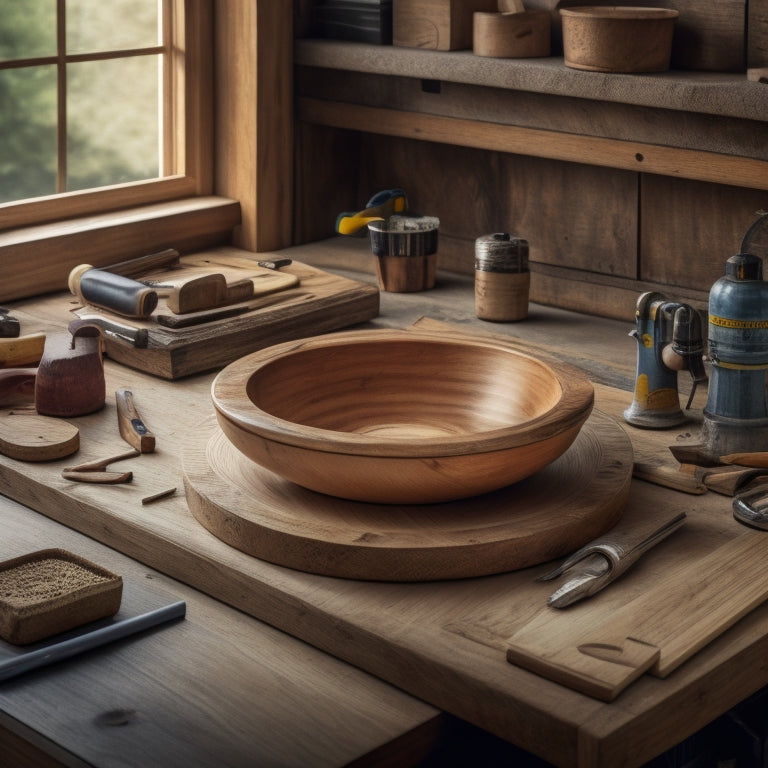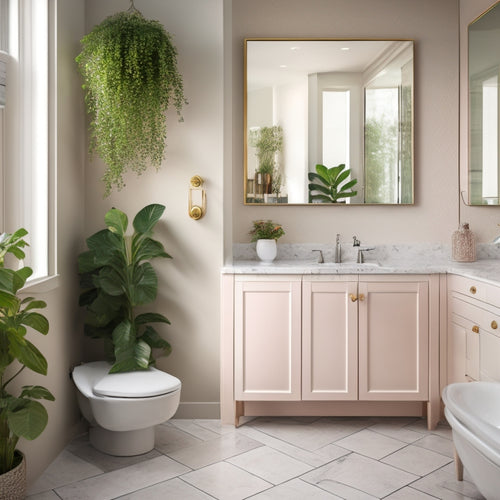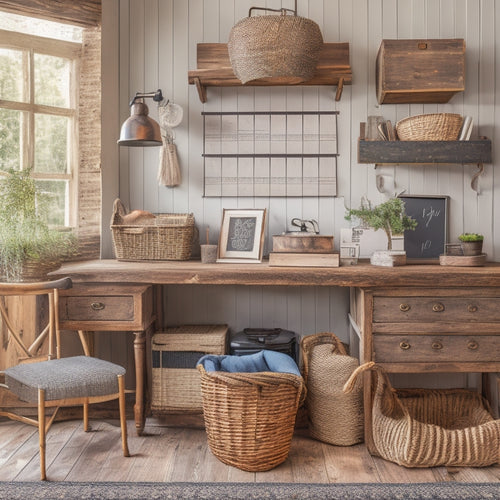
Building a Bathroom Wood Sink From Scratch
Share
As you commence on building a bathroom wood sink from scratch, you'll need to start by choosing the right wood type, considering durability, moisture resistance, aesthetic appeal, and long-term viability. Next, design the sink's dimensions, focusing on ergonomics, precision, and functionality. Set up your workspace, preparing areas for cutting, assembling, measuring, and cleaning. Cut and treat the wood pieces, applying waterproof sealants and sanding to a fine finish. Assemble the sink structure, ensuring a watertight seal and level verification. With these foundational steps complete, you're just getting started on crafting a unique and functional bathroom wood sink that will enhance your space - but first, you'll want to tackle the finer details of sanding, finishing, and installation.
Key Takeaways
- Choose durable hardwoods like teak, ipe, or ebony with high Janka ratings for resistance to rot and moisture damage.
- Design the sink's dimensions considering ergonomics, precision, and functionality, with a height of 29-34 inches and depth of 5-7 inches.
- Prepare the workspace with separate zones for cutting, assembly, storage, measuring, and cleaning to maintain safety and efficiency.
- Cut and treat wood pieces with precision, applying waterproof sealant, wood oil, or polyurethane finish, and sanding to a fine finish.
- Assemble the sink structure by attaching the sink apron and basin, ensuring waterproofing, level verification, and proper drainage alignment.
Choosing the Right Wood Type
When selecting the ideal wood type for your bathroom wood sink, three primary considerations come into play: durability, moisture resistance, and aesthetic appeal.
You'll want a wood that can withstand the humid environment and water exposure, so wood durability is vital. Look for hardwoods with high Janka ratings, like teak, ipe, or ebony, which are naturally more resistant to rot and decay.
Water resistance is also fundamental, as your sink will be exposed to water daily. You can enhance the wood's natural resistance with a waterproof coating or sealant, but it's important to choose a wood that's inherently resistant to water damage.
Some woods, like cedar and redwood, contain oils that repel water, making them suitable options.
Lastly, consider the aesthetic appeal of your chosen wood. Since the sink is a focal point in the bathroom, you'll want a wood that adds warmth and style to the space.
Consider the color, grain pattern, and texture of the wood to ascertain it complements your bathroom's overall design.
Designing the Sink's Dimensions
With your ideal wood type selected, you're ready to move on to designing the sink's dimensions. This is where the fun begins – and by fun, I mean math and measurements. Don't worry, it's worth it!
You'll need to decide on a sink style that fits your bathroom's aesthetic. Are you going for a sleek, modern vessel sink or a more traditional undermount sink? Each style has its own set of dimensions to take into account.
When choosing your sink's dimensions, keep ergonomic aspects in mind. Think about the height and depth of the sink in relation to your own height and comfort level. You don't want to be straining your back every time you wash your hands.
A good rule of thumb is to position the sink between 29 and 34 inches off the floor. As for the basin's depth, aim for around 5-7 inches to guarantee you can comfortably wash your hands without water splashing everywhere.
Take your time, and don't be afraid to sketch out some rough designs before finalizing your sink's dimensions. Remember, precision is key – you don't want any surprises when it's time to start building!
Preparing the Workspace
You'll frequently find yourself switching between tasks and tools as you work on your bathroom wood sink project, so it is essential to set up a well-organized workspace that accommodates your needs. A cluttered workspace can lead to mistakes, wasted time, and even safety hazards. To avoid these issues, take the time to set up your workspace thoughtfully.
| Zone | Tools/Supplies | Safety Precautions |
|---|---|---|
| Cutting Zone | Table saw, miter saw, jigsaw, safety glasses | Keep loose clothing and long hair tied back, avoid overreaching |
| Assembly Zone | Workbench, clamps, drill press, measuring tape | Guarantee a stable work surface, avoid over-tightening clamps |
| Storage Zone | Shelving, cabinets, storage bins | Keep heavy objects at a safe height, avoid tripping hazards |
| Measuring Zone | Measuring tools, calculator, pencil and paper | Double-check calculations, use a stable surface |
| Cleaning Zone | Vacuum, broom, dustpan, trash can | Sweep and vacuum regularly, avoid slipping hazards |
Cutting the Wood Pieces
You'll need to prepare your wood for cutting by planing and jointing it to guarantee straight, flat, and smooth surfaces.
Next, you'll employ precise cutting techniques, such as using a table saw or miter saw, to make accurate cuts.
Before making any cuts, double-check your measurements to avoid errors, as accurate measurements are essential for a well-fitting sink.
Wood Preparation Methods
Cutting the wood pieces is an essential step in building a bathroom wood sink, as it sets the stage for the entire project.
Now that you've got your wood cut to size, it's time to prepare it for the sink's unique demands. You'll need to take into account wood treatment options to guarantee your sink can withstand the moisture-rich bathroom environment.
Moisture resistance is key, so you'll want to apply a wood treatment that repels water and prevents warping or rotting. You can opt for a waterproof sealant, a wood oil, or a polyurethane-based finish. Each has its pros and cons, so research and choose the one that best fits your project's needs.
Before applying your chosen treatment, make certain the wood is sanded to a fine finish. This will help the treatment adhere evenly and prevent any imperfections from showing through.
You should also remove any dust or debris from the sanding process to ascertain a smooth, even application. By taking the time to properly prepare your wood, you'll be rewarded with a beautiful, functional sink that will last for years to come.
Precise Cutting Techniques
The bathroom wood sink's design demands precise cutting techniques to guarantee a flawless fit and minimize waste.
You'll need to employ a combination of jig saw techniques and hand saw precision to achieve the intricate cuts required for this project. Start by using a jig saw to make curved cuts, carefully following the template or pattern you've created.
For straight cuts, switch to a hand saw, focusing on precision and control to avoid splintering or tearing the wood. When cutting joints, use a miter saw or a hand saw with a miter box to ascertain accurate 45-degree angles.
Remember to cut slowly and deliberately, as rushed cuts can lead to mistakes and wasted materials. To minimize error, cut each piece slightly oversized, then sand to fit.
Measuring for Accuracy
Every wood piece must be precisely measured and marked to confirm a flawless fit in your bathroom wood sink. You can't afford to wing it here, folks! To ascertain accuracy, gather your trusty measuring tools, including a tape measure, calipers, and a combination square.
Don't even think about using that rusty old ruler from high school – we're going for precision here.
When measuring, use a combination of measurement techniques to double-check your numbers. For example, measure the length of a piece in multiple spots to account for any warping or unevenness.
And don't forget to mark your measurements clearly on the wood, using a fine-tip marker or pencil. A tiny mistake now can translate to a major headache later on.
Take your time, and remember that measuring twice is always better than cutting once (and regretting it). With careful measurement and marking, you'll be ready to start cutting your wood pieces with confidence.
Assembling the Sink Structure
With all the necessary components within reach, begin by attaching the sink apron to the countertop support frame, guaranteeing a flush alignment between the two. This is essential for maintaining sink stability and preventing water from seeping behind the sink.
Use waterproofing techniques, such as applying a bead of silicone sealant to the apron's edges, to secure a watertight seal.
Next, attach the sink basin to the apron, making sure it's centered and evenly spaced. You'll need to secure it using screws or brackets, depending on your design.
Here are some key considerations to keep in mind:
- Verify the sink basin is level to prevent water from pooling in one area.
- Use a waterproof adhesive to attach the sink basin to the apron.
- Double-check the sink's drainage system to confirm it's properly aligned.
- Leave a small gap between the sink basin and apron for expansion and contraction.
Sanding and Smoothening
You're now ready to move on to the sanding and smoothening stage, where you'll refine your wood sink's surface to a silky finish.
To achieve this, you'll need to select the right sandpaper for the job, carefully removing imperfections layer by layer.
Sandpaper Selection Guide
When tackling the sanding and smoothening process, selecting the right sandpaper is essential for achieving a professional finish on your bathroom wood sink.
You'll be working with a variety of sandpaper grits, and understanding their differences will make all the difference in your project's outcome.
Here are some key factors to take into account when choosing the right sandpaper for your project:
-
Grit progression: Start with coarse grits (80-100) for removing imperfections, then progress to finer grits (120-150) for smoothening, and finally, use high-grit sandpaper (220-240) for a polished finish.
-
Open-coat vs. closed-coat: Open-coat sandpaper is better for removing material quickly, while closed-coat sandpaper is ideal for finer sanding techniques.
-
Aluminum oxide vs. silicon carbide: Aluminum oxide is a good all-purpose choice, while silicon carbide is better suited for sanding metal or hardwoods.
- Wet sanding vs. dry sanding: Wet sanding reduces scratches and dust, but dry sanding is better for removing old finishes or sanding down rough wood.
Removing Imperfections Slowly
Removing imperfections from your bathroom wood sink is a precise process that requires patience and attention to detail. You've got to be willing to put in the elbow grease to get that silky smooth finish.
Now, let's get down to business. You've got a few types of imperfections to tackle: scratches, swirl marks, and those pesky tiny divots.
Start with your coarsest grit sandpaper (around 120) and work your way up to the finer grits (220, 320, and so on). As you sand, keep an eye out for those imperfections and focus on the trouble areas first.
Remember, gradual improvement is key here. Don't try to rush it – you'll only end up making things worse. Take your time, and with each pass, inspect your work to see how you're doing.
You might need to revisit areas multiple times before they're completely smooth. Be patient, and you'll be rewarded with a sink that looks like a work of art.
Final Smoothing Techniques
The wood sink's surface, now refined from coarse to fine grits, is ready for the final smoothing techniques that will enhance its appearance to a high-gloss finish.
You've made it this far, and now it's time to bring out the big guns – or rather, the fine-grit sandpaper and specialized smoothing tools.
To achieve that showroom shine, you'll need to employ a combination of finishing techniques. These include:
- Using progressively finer grits of sandpaper (up to 220 or higher) to remove any remaining scratches or imperfections
- Applying a wood conditioner or sealant to protect the wood and bring out its natural beauty
- Utilizing a power buffer or rotary tool with a polishing attachment to apply a high-gloss finish
- Hand-sanding with a micro-mesh pad to eliminate any remaining minor scratches or swirl marks
Applying the Finish Coat
Finishing touches are within reach as you prepare to apply the finish coat, an essential step that enhances your bathroom wood sink from mere functionality to a stunning visual statement.
This is where patience and attention to detail really pay off, so don't rush through this process! You've got two main finish application techniques to choose from: brushing or spraying. Brushing provides more control, especially in tight spaces, while spraying yields a smoother finish.
Whichever method you choose, verify to work in a well-ventilated area and follow the manufacturer's instructions.
When it comes to wood sealant options, you've got a range of choices. Oil-based polyurethane provides a rich, warm glow, while water-based polyurethane is a more eco-friendly option.
You could also opt for a natural oil finish, like tung oil or linseed oil, for a more subtle look. Regardless of which sealant you choose, apply it in thin, even coats, allowing each layer to dry before applying the next.
Remember to sand lightly between coats to ascertain a silky smooth finish. With the right finish coat, your bathroom wood sink will be the envy of all your friends!
Installing the Faucet System
Every bathroom wood sink requires a reliable faucet system to function properly, and now it's time to bring yours to life.
You've got the hard part out of the way – building the sink itself – and now it's time to focus on the fun part: making it functional.
When choosing a faucet, you'll need to take into account the type that best suits your sink's design. Do you prefer a single-handle, two-handle, or touchless faucet? Each type has its own set of installation requirements, so verify you choose one that's compatible with your plumbing setup.
Here are a few things to keep in mind when installing your faucet system:
-
Measure twice, install once: Double-check your faucet's installation instructions to confirm you've got the right measurements and hardware.
-
Don't forget the mounting hardware: You'll need to attach the faucet to the sink, so verify you've got the right screws, clips, or other hardware.
-
Check for leaks: Before you start using your sink, turn on the water and inspect the faucet and pipes for any signs of leaks.
- Think about adding a water filter: If you want to get fancy, you can install a water filter or purification system to give your sink an extra layer of functionality.
Final Touches and Inspection
You're almost there! The final stretch of building your bathroom wood sink from scratch is upon you. It's time to add the finishing touches and inspect your handiwork.
| Task | Description | Tips |
|---|---|---|
| Seal the wood | Apply a water-resistant finish to protect the wood | Use a food-safe sealant for peace of mind |
| Install the drain | Connect the drain to the sink and plumbing system | Verify a snug fit to prevent leaks |
| Add decorative trim | Conceal any gaps or edges with decorative trim | Choose a style that matches your bathroom aesthetic |
| Inspect the faucet | Check for leaks and proper function | Run water through the faucet to test |
| Final inspection | Walk around the sink, checking for any imperfections | Take notes and make adjustments as needed |
Remember to take plumbing considerations into account, such as verifying the drain is properly vented, and maintenance tips, like regularly cleaning the sink to prevent water spots. With these final touches, you'll be enjoying your new bathroom wood sink in no time!
Frequently Asked Questions
Can I Use Reclaimed or Recycled Wood for My Bathroom Sink?
You're a eco-warrior at heart, and using reclaimed or recycled wood for your bathroom sink is a fantastic idea, offering sustainability benefits like reduced waste and a unique story to tell; just be prepared for extra maintenance tips to keep it looking fabulous!
How Do I Ensure the Sink Is Waterproof and Durable?
You've heard the rumors: wood sinks are doomed to rot. But, you're determined to defy the odds! To guarantee your creation stays waterproof and durable, apply a waterproof finish like tung oil or polyurethane, and install a dependable drainage solution, like a sloped basin or overflow system.
Are There Any Specific Tools Required for This Project?
When tackling a wood project, you'll need to prioritize tool selection, ensuring you have a table saw, drill press, and router for precise cuts and a waterproof seal. Don't forget wood treatment tools, like a planer and sander, to smooth out your sink's surface.
Can I Customize the Sink's Design to Fit My Bathroom Style?
Did you know 70% of homeowners consider their bathroom a personal oasis? You can totally customize the sink's design to fit your bathroom style! Take design inspiration from Pinterest, and infuse your personal preferences to create a one-of-a-kind creation that reflects your unique flair!
Is It Necessary to Add a Backsplash to the Wooden Sink?
You're wondering if a backsplash is a must-have, and honestly, it's not necessary, but it's a great idea! It'll protect your walls from water and stains. Choose backsplash materials that're easy to clean, and follow maintenance tips like sealing and regular wiping to keep it looking fresh!
Conclusion
You've built a bathroom wood sink from scratch, and it's a masterpiece! Your hands have crafted a functional work of art, like a conductor leading an orchestra to perfect harmony. Every cut, sand, and finish stroke has resulted in a sink that's both beautiful and durable. Now, turn on the faucet and watch water flow smoothly, feeling a sense of satisfaction and accomplishment. Your new sink is ready to serve as the centerpiece of your bathroom, a true reflection of your skill and expertise.
Related Posts
-

Stylish Corner Cabinet Ideas for Bathrooms
Looking to enhance your bathroom with stylish corner cabinets? You can maximize space and improve aesthetics at the s...
-

Farm Family's Organized Office: A Detailed Look
I've created a well-organized office space that helps my farm family stay productive and focused. My desk is organize...
-

Unleash Your Inner Artist With Watercolor Challenge
I'm taking the first step in awakening my inner artist by committing to a watercolor journey that will help me tap in...


